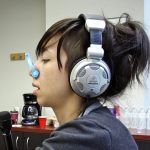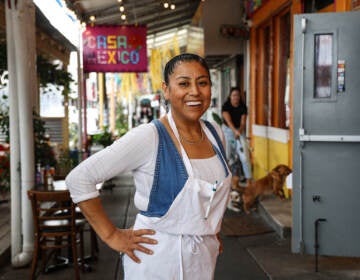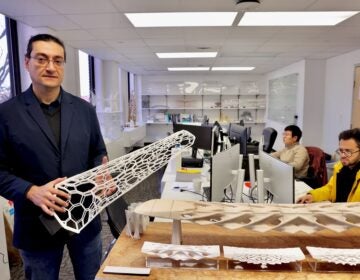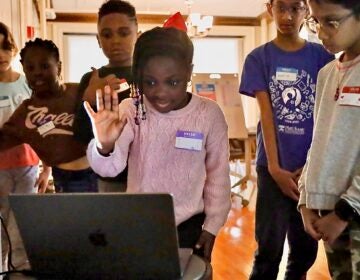Nearly 20 years after Geno’s ‘Speak English’ fracas, the Italian Market has become a hub of linguistic diversity
A study of more than 3,000 signs shows how immigrants are transforming three Philly neighborhoods.
Listen 1:13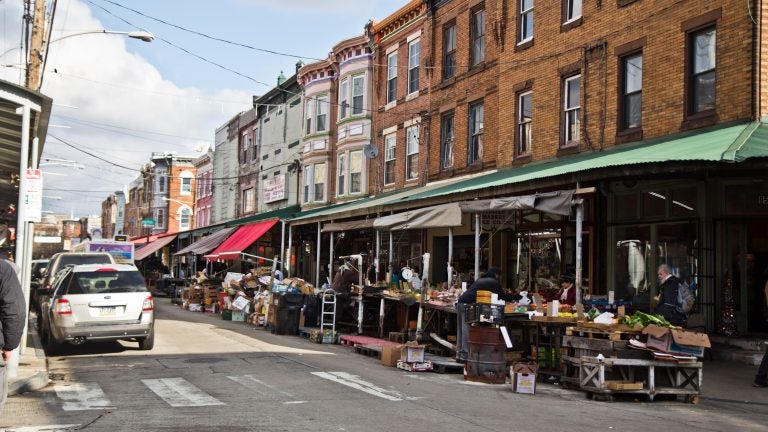
The 47 line passes through Philadelphia's iconic Ninth Street Market. | La línea 47 pasa por el icónico Ninth Street Market de Filadelfia. (Kimberly Paynter/WHYY)
From Philly and the Pa. suburbs to South Jersey and Delaware, what would you like WHYY News to cover? Let us know!
In 2020, Temple University PhD student Daniel Guarin was wandering El Centro de Oro — otherwise known as “the Golden Block” — a neighborhood in the Fairhill section of North Philadelphia that for decades has been regarded as the center of the city’s Latino community.
Guarin, who studies Hispanic linguistics, was researching how moving to the U.S. had changed the Spanish spoken by immigrants from his native Colombia.
“I went to the Golden Block to see what I could learn from it since it was the Hispanic neighborhood,” he said. “And it was shocking because most of the things that I saw there were in English.”
Guarin eventually found what he was looking for in Olney, a Colombian stronghold, but the experience sparked Guarin’s curiosity. If El Centro de Oro is no longer the center of Hispanic life in Philadelphia, what is?
And so, in 2021, Guarin launched a linguistic landscape study, a recently evolved form of research that investigates how written language is used in public spaces. Linguistic landscape studies are especially useful, Guarin said, in multilingual environments like the U.S.
“They give us an idea about language hierarchy,” he said. “You can measure how languages are coexisting and what communities live in that area.”
For the study, Guarin chose three heavily Latino neighborhoods — El Centro de Oro, Olney and the Italian Market — and between 2021 and 2023, he made regular visits in which he took photographs of signs, posters, flyers and more. By the end of the two years, he’d collected a total of 3,356 signs, which he then analyzed based on the languages they used.
Guarin found that his initial instinct was correct — Spanish-language signs had been decreasing in El Centro de Oro, a Hispanic stronghold since at least the 1970s thanks to a post-WW2 influx of Puerto Rican transplants.
“I was really expecting to find a lot of monolingual signs, mostly Spanish, but no — most of them are bilingual or signs in English,” Guarin said — a shift he attributes to a phenomenon known as linguistic attrition.
“The idea is that by the third generation, speakers start losing their language,” he said. “So those people who founded the Golden Block, the Puerto Rican diaspora, are not the [only] ones who are living there anymore. Their children and the grandchildren are the ones who are really running the space, and they have a tendency to move from Spanish to English since they were born in the U.S. and they started developing their social life in English.”
Changes in Olney — a diverse area that’s become a magnet for Colombian and Korean immigrants — proved less straightforward. There, Spanish signs decreased and then increased again over the two-year span. Guarin’s bigger takeaways were the strength and vibrancy of Olney’s Colombian community and its integration with English- and Korean-speaking neighbors.
“I got really good Colombian food there,” he said. “It was nice to feel like I was back home.”
The most dramatic shifts that Guarin observed were in the Italian Market.
“South Philadelphia’s Italian Market is such a fascinating place,” he said. “There are so many things going on there from a linguistic point of view.”
Across all three neighborhoods, English was dominant. But in the Italian Market, Guarin said, that’s starting to change. From 2021 to 2023, he saw English signs in the Italian Market decrease from 72% to 51%, while Spanish signs doubled from 18% to 36%. He also found a growing number of multilingual signs.
“It’s not difficult to find a random sign on a pole with information written in English and then Spanish, Khmer, which is the language in Cambodia, and Vietnamese,” he said. “So there’s this sort of network of people communicating through written language — and all that is happening in five blocks of South Philly.”
While multilingual signs accounted for fewer than 1% of the 3,000-plus signs in the study, they made a deep impression on Guarin, who recounted flyers for block parties (English, Spanish and Vietnamese), a billboard advertising a bank (English, Spanish, Vietnamese and Mandarin) and a sign for a poultry store (English, Spanish, Vietnamese and Arabic).
The diversity of languages and cultures is especially striking, Guarin said, given that in 2006, the South Philadelphia neighborhood gained national notoriety after Geno’s Steaks posted a sign that read, “This Is America. When Ordering Please Speak English.”
“So seeing multilingualism or signs in multiple languages coexisting is a beautiful way to show that we can actually welcome all languages and help each other no matter what language we speak,” Guarin said. “We share the space, we both take care of the space. So our languages are all welcome here. It’s no longer us versus them.”
To read more about the study, visit Guarin’s write-up on The Conversation.

Get daily updates from WHYY News!
WHYY is your source for fact-based, in-depth journalism and information. As a nonprofit organization, we rely on financial support from readers like you. Please give today.


